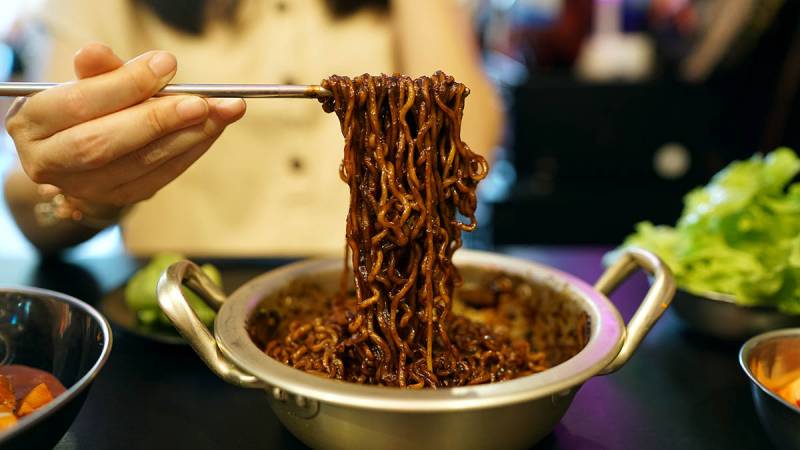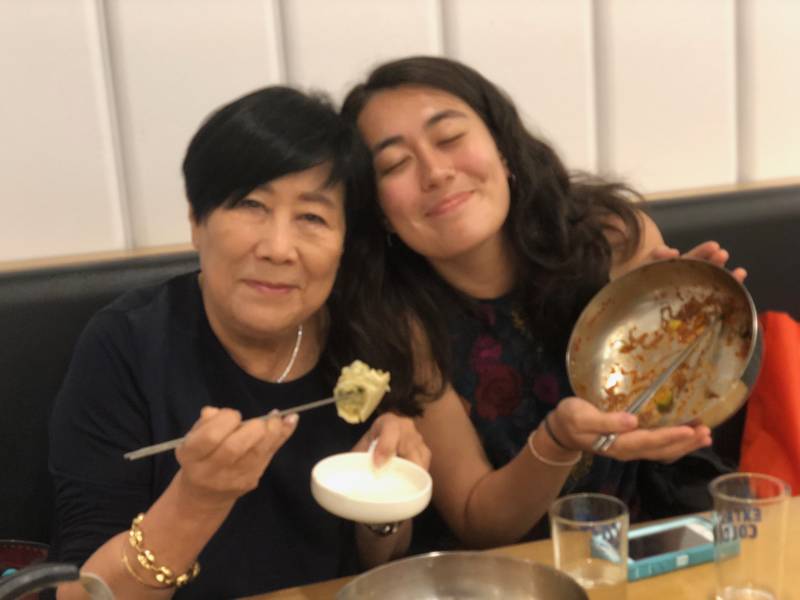My first encounter with jajangmyeon was a revelatory experience. Two years ago, I was in Seoul with my grandmother, eating our way through her home city when we ended up on a dedicated noodle journey. Yesterday’s lunch had been a chilled metal bowl of naengmyeon, extremely chewy buckwheat noodles served in a cold beef broth punched up with acidic kimchi juice and chalky slices of hard boiled egg. The day before, sweating in the June humidity at a stall in Gwangjang market, we’d slurped down kal guksu, knife cut noodles served with beef broth, carrots, cabbage, and shredded toasted seaweed on top. Just when I was certain there was no room left in my heart, or stomach, for another breathtaking bowl of noodles, we went to a fancy Chinese restaurant in Gangnam. The host led us to our table in a darkly lit room filled with stylish people in designer clothes and my grandmother ordered us heaping bowls of jajangmyeon. We tucked our napkins into our shirt collars and dug our chopsticks in to mix the noodles until they were slick with black sauce. The hand-pulled noodles were balanced: not too thick, gummy, or ethereal, with a bouncy chew. My grandmother and I slurped our bowls clean, waddled back to our Airbnb, and spent the rest of the trip talking about how incredible those noodles were.
The Reliable Comfort of Jajangmyeon

It’s not an exaggeration to say that I could write sonnets about jajangmyeon. The elements are all there: toothsome, chewy noodles topped with chunjang, a thick fermented black bean sauce cooked with small pieces of fatty pork, zucchini, and onion. The glossy sauce is adorned with crunchy, electric-yellow pickled danmuji (daikon), raw white onion, and matchstick cut cucumber. The richness of the chunjang, rivaling that of a slow-cooked bolognese, is balanced by the sweet acidity of danmuji cutting through the savoriness like a breath of fresh air. To me jajangmyeon is a comfort food to end all comfort foods, a healing salve for all occasions. It’s for filling a cavernously empty stomach, for soothing period cramps, and for nights when the world sits too heavily on your shoulders.

In my experience noodles are remarkable starting points for larger conversations about cultural history, politics, and diaspora. That naengmyeon lunch led to a discussion about the dish’s North Korean origin and my grandmother’s thoughts on reunification. Photos of kal guksu yielded a 30-minute lecture from my father about how wheat-based noodles became popularized during the Korean war, when American wheat flour was distributed with rations.
Jajangmyeon proves to be no different, as its nation-spanning origins can spark feisty debates about the dish’s cultural heritage. The dish arrived in Korea when Chinese immigrants brought Shandong-style zhajiangmian to Incheon. From its diasporic beginnings, the Koreanized Chinese dish evolved in context to become a unique phenomenon in Korean culture. Popularly eaten on Black Day —the anti-Valentine’s holiday for sad singles— the dish is the most common takeout food in the nation. It has also spawned an extremely gushy subgenre of ASMR mukbangs. Regardless of how you choose to classify jajangmyeon, the dish in mainstream Bay Area food culture still lives in shocking anonymity. You can order jajangmyeon at Chinese, Korean and Korean-Chinese restaurants under its many names (meat sauce noodles, zha jiang mian, jajangmyeon) and determine which interpretation best satisfies your particular palate (one writer, driven by a craving much like mine, did so for restaurants in San Francisco).
As months of pandemic-induced isolation ticked by and my mental health increasingly deteriorated, the specter of my perfect bowl of jajangmyeon began to haunt me. I followed Maangchi’s recipe to make decent at-home versions, but they never quite hit the spot.
Everything changed when a friend directed me to Yu Yu Za Zang on Telegraph Ave in Oakland. I must have driven by the storefront hundreds of times on frequent trips to Koreana Plaza throughout my life, but I had overlooked it, even with the neon lettering in the window displaying the dish’s name in hangul (of course, when I asked my grandmother if she had tried this spot, it turned out that it’s her preferred restaurant in Oakland for jajangmyeon).
In its takeout form from Yu Yu Za Zang, the dish comes with sauce and noodles in separate containers, radish and onion fixings in tiny plastic cups. I mixed the noodles and promptly splattered black sauce everywhere with furious slurping. I had found my glass slipper, my ideal jajangmyeon, hidden in plain sight just a few blocks from my apartment. It was a rom-com moment of falling in love with the person next-door, but with noodles.
The dish’s allure comes from the comforting assurance that even during the worst of times, the perfect noodles, with their magic power to soothe all ailments, can be slurped down while ugly-crying in pajamas. Jajangmyeon may elude easy classification, but when it exists somewhere out there, there is the certain promise of feeling okay. Because when one’s belly is full of noodles, it’s easier to believe that better days will come.